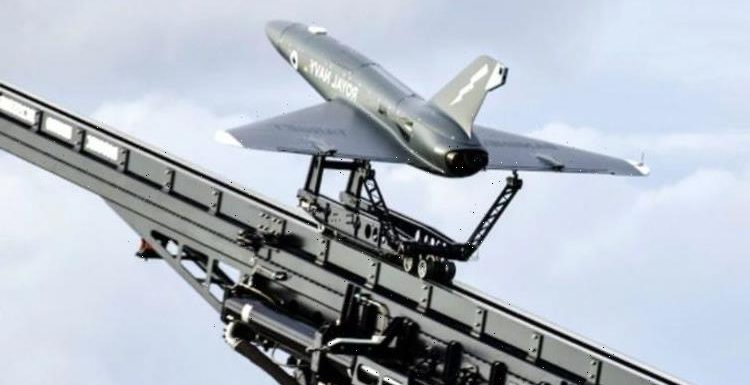
Afghanistan: US carry out drone strike on vehicle
We use your sign-up to provide content in ways you’ve consented to and to improve our understanding of you. This may include adverts from us and 3rd parties based on our understanding. You can unsubscribe at any time. More info
The fixed-wing aircraft, which has been given the name QinetiQ Banshee Jet 80+, flew from the carrier’s flight deck. Flight Test Engineers and operators from QinetiQ, which owns and operates the Banshee, flew three of the air vehicles from the drone’s launcher on the Hebrides range off the northwest coast of Scotland. The system will be used to test future sensors, weapons and radio equipment.
Banshee can soar at speeds of up to 460mph and can also travel up to 25,000ft high in the sky.
It has been called a realistic adversary for sailors training to counter aerial threats as it is hard to detect on radar.
The Banshee flights are the first step for the Royal Navy in exploring how crewless technology can be operated from Queen Elizabeth-class aircraft carriers in the future.
Commander Rob Taylor, the Ministry of Defence’s lead for Royal Navy air test and evaluation, said: “There is a real need for a low-cost drone such as the Banshee that can replicate a range of the threats in the skies and provide a testbed for future payloads.”


“A warship can carry this drone with it on operations, launch it and use it to keep personnel razor-sharp in countering threats from above.
“The ability to adapt the payload for differing tasks is also crucial to provide value for money and interoperability across the fleet.”
Military forces are now developing more and more uncrewed systems to extend mission endurance and reduce the risk to service personnel.
Drones will be used to carry out tasks like aerial reconnaissance and communications as well as for carrying weapons.

Most drones will operate by themselves, but some will be deployed as what are known as “loyal wingmen”, controlled from the air by another aircraft under a pilot’s control.
The Ministry of Defence is now looking into “drone swarms” to overload enemy defences as Britain signals its commitment to protecting itself in the event of conflict.
The RAF has made its 216 Squadron the lead unit for drone technology in the UK.
After the trial, the Banshee that flew from the carrier was recovered after it landed by parachute.
DON’T MISS
Starmer slammed for ‘new policy’ to make UK ‘world leader’ in science [INSIGHT]
Germany faces worse gas crisis as Britain outsmarts Putin [REVEAL]
Britons face £2,500 bill to replace unsuitable heating pipes [REPORT]


The trial was part of the Royal Navy’s Project Vampire, which looks at lightweight, carrier-borne drones.
The end goal of the project is to be able to eventually land aircraft back on the ships they get launched from.
Cdr Taylor added: “The programme will look at rotary-wing and fixed-wing drones to fulfil a number of tasks to increase mass on the carriers and allow crewed aircraft to maximise their capacity.
Source: Read Full Article